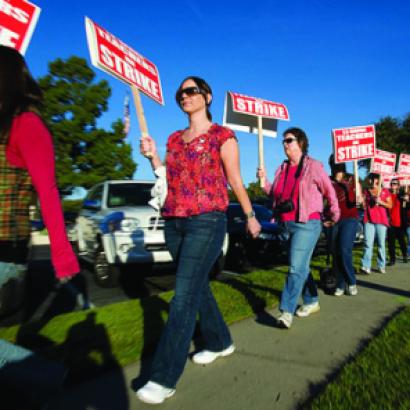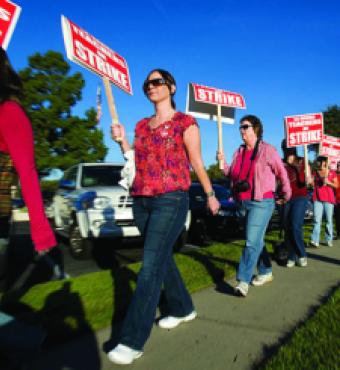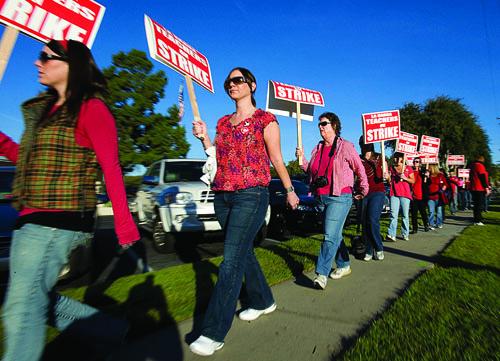- Education
- Politics, Institutions, and Public Opinion
- State & Local
- California
When teachers in Los Angeles and Oakland went on strike earlier this year, they got a considerable amount of public support. This support is not too surprising, because there is widespread belief that teachers are underpaid. Now that the strikes have been settled, how should we view these actions?
The unions (generally supported by the media) have argued that anything that makes the teachers better off must be better for the students. Unfortunately, while there are valid arguments that teacher salaries and working conditions need to be improved, the strikes are unlikely to lead to any significant improvement in California schools.
There is clear evidence that teachers are indeed underpaid. Research that I have done with some colleagues indicates that nationally teachers are paid 22 percent less than they could expect to earn outside of teaching. This figure comes from a unique survey by the Organisation for Economic Co-operation and Development, where a representative sample of adult workers provided information about careers and work histories and also took standardized math and reading tests. This “teacher discount” figure comes from comparing salaries of teachers to those of other college graduates with the same experience levels and the same measured cognitive skills.
Given that sizable discount, it is not surprising that we fail to recruit teachers from high within their college class rankings. Indeed, we get a surprisingly good set of people willing to be teachers. Whether they are responding to “a calling,” a desire to work with youth, a preference for the school calendar with time off in the summer, or what have you, we have been able to attract a generally good set of teachers.
Other research is also clear that if we want to improve the schools, we will need to upgrade the effectiveness of our teachers. It is doubtful that we can do this by pushing harder to convince more college students that they should ignore any salary discounts and enter teaching.
While there were other issues at stake in pre-strike and post-strike discussions, they mostly emphasized overall salary increases (new contracts raised them 6% in Los Angeles and 11% in Oakland). These amounts do not close the salary gaps that exist, but they move in that direction. Thus, can’t we conclude that the teacher strikes may be serving the state and the national interest by lessening the teacher discount and by making teaching more attractive to prospective teachers?
In assessing the impact of these increases, one must recognize that salary and compensation discussions actually fall into two broad and distinct groupings—those that incorporate teacher effectiveness and those that do not. These recent strike-inspired salary increases are squarely in the “do not” grouping. In the build-up to the strikes and in the after-discussions, the topic of teacher effectiveness never made it to the surface. That is a critical problem.
Across-the-board increases undoubtedly make the recipients happier, but it is unlikely to have any discernible impact on students. Less-effective teachers can be assumed to like more money as much as more-effective teachers. Most teachers are not holding back their good teaching until they are offered more money, so the added salaries are also unlikely to change what goes on in the classroom. The added salary will generally work to reduce teacher turnover and attrition, but the teachers who remain in the schools and what goes on in the classroom will be very similar to what we see now.
Salary policies that do not discuss effectiveness generally suggest that these are nonetheless ways that might lead to improved schools. The improvement, in theory, comes from making the occupation generally more attractive, thus inducing more college graduates to consider teaching and expanding the pool of job applicants.
But this theory introduces a number of assumptions that must be met before they can result in improvement of the schools.
First, we must assume that the expansion of the pool happens in ways that we want—such as getting smarter people or specialists in particular fields to consider teaching.
Second, it assumes that schools can select well from the expanded applicant pool.
Third, because it takes considerable time until the new, “better” teachers become a significant portion of the total teacher force, it assumes that we continue this policy for some time, even though any observable impact on students will be hard to see for many years. The validity of each of these assumptions is not supported by existing evidence.
In other discussions that go beyond the current strike-based salary increases, the across-the-board increases are replaced by various proposals to address some of the observed deficiencies. The broad increases have obvious appeal to the unions, because they mobilize all of their members. But this makes the policies very expensive and slows down any possible adjustments to the teaching force. One alternative approach would be to weight the increases toward entering teachers. Other proposals would give college-tuition forgiveness to prospective teachers, perhaps based on their willingness to teach in specific locations (such as rural areas or inner cities), or would base the possibility of tuition assistance on the recipient’s college major (e.g., STEM fields), GPA, or test scores. Yet another would give mortgage assistance (or housing) to new teachers.
Each of these methods tries to expand the pool of potential teachers in desirable ways but without directly paying for what we want. However, policies that ignore effectiveness in the classroom such as these entry programs still miss the fact that it is very difficult to choose a good teacher before the person is actually in the classroom and performing the job. While STEM tuition-forgiveness programs might get more biology majors in teaching, the existing research indicates that there is still a large variation in the actual effectiveness of such teachers.
In simple terms, it is almost always a much better policy to provide incentives—i.e., to pay for—the thing that we want. If we want effective teachers, we should increase the salaries of effective teachers.
The difficulty, of course, with tilting any salary improvements toward effective teachers is that one must be able to identify the effective teachers. That requires a valid and reliable assessment system. The unions have found it possible to argue that this is always an insurmountable obstacle, because all evaluation systems will make mistakes.
But that criticism holds throughout the economy. There are no mistake-proof evaluation systems. Yet the rest of the economy sees the value of using evaluations for personnel systems even if there are some mistakes. Is teaching different from all other occupations in terms of the lack of tolerance of any mistakes?
We need to improve the overall effectiveness of our teaching force, and we will not do this by ignoring the differences between effective and ineffective teachers.
















